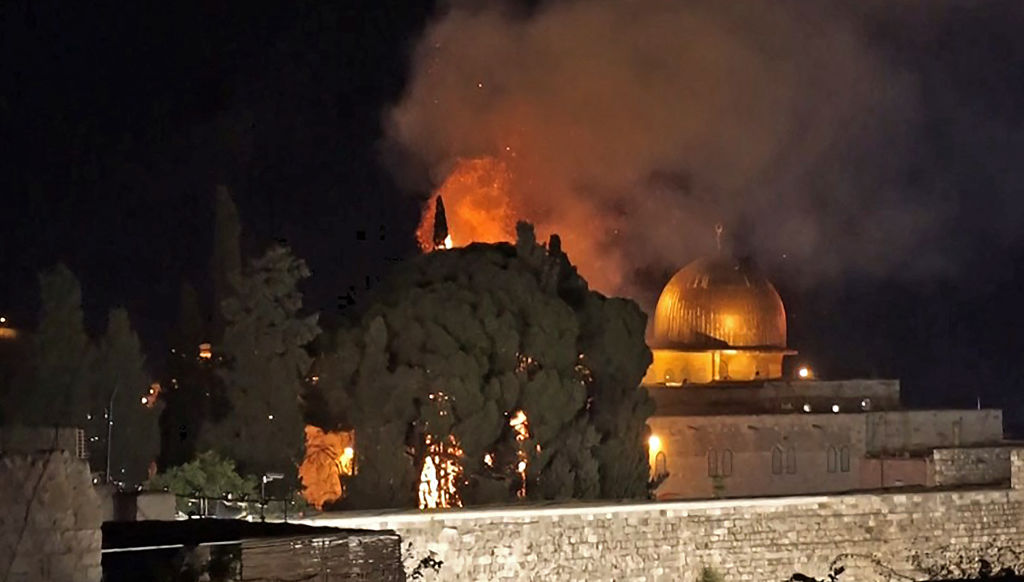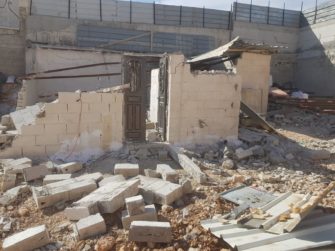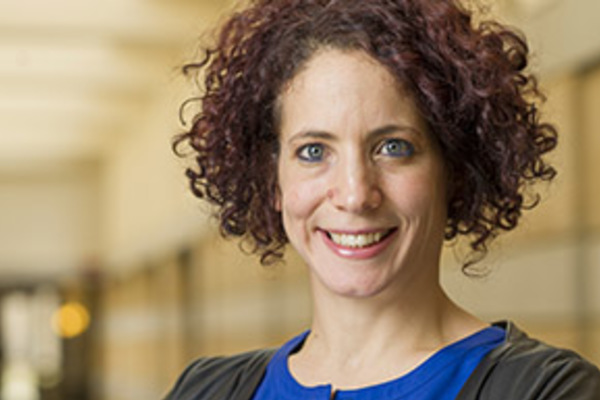
Religion is Both Gasoline and Fire
The apocalypse does not just happen. Sure, the case of Palestine/Israel often triggers the use of end-time script metaphors, but their deployment only obscures the anatomy of power, ideology, and oppression. The Palestinians are not the only prisoners of this oppression. Jews and Judaism too are imprisoned within the cages of a nationalistic supremacist ideology, one that needs to be distinguished from Zion as the subject of Jewish longing and messianic anticipation that is hardwired into the tradition. The apocalypse does not just happen. The illusion of cosmic catastrophe serves a political agenda and ideology.
We witness now, in 2021, yet another escalation in Jerusalem, Gaza, and across the “mixed cities” of Israel where belligerent Jewish products of religious Zionism and pre-military religious academies, along with religious Zionists bused from settlements in the West Bank and other Jewish-Israeli bystanders, target Palestinian-Israelis (their neighbors). These Palestinians trace their roots to cities like Lod, Jaffa, and Haifa going back centuries prior to the Catastrophe of 1948 (the Nakba) and the establishment of Israel. These cities are “mixed,” sometimes even celebrated as models of “coexistence,” because the events of the Nakba stopped short of a total ethnic cleansing. The sight of kippa-wearing youth roaming streets with the intentions of a murderous mob to eliminate the Palestinian presence in the cities exposes how religion, when not properly contextualized, becomes both gasoline and fire, a weapon of distraction away from ongoing realities of dispossession and elimination.
An All-Consuming Fire
In May of 2021, during the final days of the sacred month of Ramadan, images of flames billowing up from the Haram al-Sharif as a frenzied crowd of Jewish Israeli religious (mostly) youth sings Biblical revenge songs in Hebrew were spread across social media. These images may come across as an expression or anticipation of an apocalyptic drama. But what they truly expose is why playing with religion could literally be like playing with an all-consuming fire. Unlike the fire burning through the biblical image of the “burning bush,” the miraculous illumination to Moses that called him to pave a path for his people’s liberation from slavery and oppression, this metaphorical ethnoreligious nationalist fire literally threatens total erasure by consolidating a Jewish supremacist regime. Now, it is clear that this all-consuming fire does not only take the shape of “bombing Gaza back to the stone age” as Benny Ganz, the current Defense Minister, boasted about his “accomplishment” (then as the Army Chief) in 2014. The fire now “spreads” to the “mixed cities” inside Israel. This offers a moment of clarity. Respectable human rights organizations have recently confirmed with ample evidence the current Israeli regime as supremacist in its ideology by labelling it an apartheid regime. Certainly, it is hard to look at the display of Jewish ultranationalist youth singing violent Jewish songs on the plaza in front of the Western Wall where once, before 1967, the Palestinian Mughrabi Quarter had stood—that is, before it was abruptly demolished in the aftermath of the Six-Day War–and not reach the same conclusion.
מזעזע pic.twitter.com/7JM5ADoPJf
— איימן עודה أيمن عودة Ayman Odeh (@AyOdeh) May 10, 2021
Twitter post by Joint List Knesset Member Ayman Odeh, of Jewish youth celebrating Jerusalem Day and singing “Yimach shemam” (may their names be erased).
National Idolatry
Of course it is hard to escape an apocalyptic foreshadowing when the hateful chants loudly invade the soundscapes and flames from the Haram al-Sharif reach the night sky. Ominous are the images of the flames emerging from this sacred site for Muslims when they are combined with the soundtrack of genocidal Hebrew words sung in front of the Wailing Wall. This wall, it must be remembered, is the last standing remnant of the Herodian Temple. The late Jewish-Israeli sage Yeshayahu Leibowitz condemned it as a site of national idolatry. Another wall, the so-called apartheid or separation wall that has walled off the territories occupied in 1967 (but swallowed further lands in pursuit of its “security” function), has reconfigured the Western Wall as not only a locus of religious piety, but also a locus of nationalist piety. The meanings behind these walls converge when the idolatry of the nation is confused with Jewish piety. Leibowitz saw this happening long before the settler lobby and the so-called “hilltop settlers” began to explicitly dictate the tone of Israeli annexationist policies.
The image of the fire and the sounds of those singing are chilling. Conversations on social media seemed to focus on who started the fire and why. This focus on the minutiae of who started the fire, and why it was started, can seem extraneous in light of the horrific nature of these videos. Still, the details are important. In reality, the fire was likely caused by Palestinian protesters at the al-Aqsa compound, who, prior to and during the month of Ramadan have been engaging in grassroots protests against the looming dispossession of families from the occupied East Jerusalem neighborhood of Sheikh Jarrah and resisting police brutality that has come in the wake of the protests. The Israeli government further escalated the situation when, on Laylat al Qadr, one of the holiest nights in the Muslim calendar, its security forces raided the mosque—which is a sacred space and a symbol of Palestinian sovereignty and resistance. Under the guise of security, road blocks were also set up to prevent Palestinian citizens of Israel access to al-Aqsa. The confluence of sacred times and spaces (national and religious) is explosive, and those pulling triggers and making decisions targeting religious celebrations may well be lighting the fuse.
Deadly Religion
As noted above, the literal flames were probably caused by a firework lit by protesters that misfired into a tree and were shortly extinguished. The Hebrew chants, like the daily and escalating violence of religious students of pre-military (supposedly Torah-centric) academies in the “mixed cities,” however, were caused by decades of ideologically driven policies of land grabbing, impunity, the manipulation of marginalized (mostly Mizrahi) communities, and the instrumentalization of religion to promote power and ideology. The flames were accidental, and their confluence with the hateful chants was coincidental, or so apologists say. The ultranationalist religious youth seen chanting were redirected to the Western Wall to avoid having their usual “flag parade,” which is the annual marking of the “liberation” or “reunification” of Jerusalem in 1967, proceed through the Muslim Quarter. This notorious annual display of violence in occupied East Jerusalem is met with routine impunity and as such reflects a cementing collusion between settlers and the institutions of the Israeli military and state. This collusion, like the marriage of convenience between secular “security” arguments and messianic settler aspirations to reconnect to the biblical landscape of “Judea and Samaria,” is ubiquitous across the “settlement project” in the West Bank and within the “mixed cities” of 1948 where settler organizations take over Palestinian homes through a variety of methods. These include legal and bureaucratic forms of torture which they have carried out in East Jerusalem or in other places where housing is constructed exclusively for Jews at the heart of Palestinian urban spaces.
The youth did not “come out of nowhere.” Instead, they are the product of an ideology, institutions, cynical power mongering, and the manipulation of, and selective retrieval from, religious traditions.
Messianic settler ideology, anti-Palestinian racism, and the logics of modern nationalism and settler colonialism converged at the Western Wall on this evening in an all-consuming fire sung to a religious tune. This did not “just happen.” The youth did not “come out of nowhere.” Instead, they are the product of an ideology, institutions, cynical power mongering, and the manipulation of, and selective retrieval from, religious traditions. For example, the Torah is often read even within the secular education system as a land title. This amounts to “playing with religion” to advance the settler-colonial business of land seizure and the reshaping of the landscape through ethnic cleansing and the Judaizing of spaces. This is carried out in the neighborhoods of Jerusalem one house at a time, as the residents who will soon be dispossessed from Sheikh Jarrah can attest. The flames by the Haram al-Sharif caused by the Palestinian firework are the kind of accident that happens when one plays with fire. The display of ultranationalist Jewish hate and violence is the kind of religion one gets when religion, both a potential gasoline and fire, is turned into a deadly weapon.
Sacred Times, Sacred Spaces: A Predictable Script for Escalation
The seeming speed and ease of the escalation is also indicative of a cynical awareness of the explosive potential of arbitrary violations of an otherwise delicate status quo in Jerusalem around the management of sacred spaces and sacred times. The question is whose political expediency is served by the current escalation? The answer very likely points us back to Israeli Prime Minister Bibi Netanyahu’s precarious political situation. Under indictment for corruption and unable to form a coalition after a fourth round of elections in two years, despite bringing explicit anti-Palestinian racism to the Knesset in the form of coalition bargaining with political actors who openly advocate for ethnic cleansing, Netanyahu stands to benefit from a war. This is a familiar script to enhance “national unity” in the face of Hamas’ rockets. As Gaza is bombarded by massive artillery and whole families are buried under the rubble of their own homes, the Kahanists roam the streets and direct their murderous supremacist ideology against the Palestinian citizens of Israel. These are lynch mobs that operate with impunity. Yes, al-Aqsa, Jaffa, Haifa, and Akka (centers of Palestinians within the Green Line) are all interconnected in their experience of anti-Palestinian racism. This recent escalation clarifies the consistency between settler violence within and beyond the 1948 demarcations. How to trigger this escalation? When millions are under constant control and oppression, as is the case for 1967 and 1948 Palestinians, igniting a fire usually follows predictable patterns. The violation of sacred time and space, more often than not, serves as the gasoline.

To highlight the anatomy of power is not the same as saying that “real” religion or theology have nothing to do with the eruption of overt violence in May 2021. It is rather to say that religion is inextricably bound up with these forms of power, and needs to be engaged as such. An analysis of “religion” separated from power conveniently extracts it from the story of modernity and colonialism, exonerating it from the ways in which it is implicated in supremacist structures and ideologies. Violent raids of the Haram al-Sharif during Ramadan primed Hamas to fire rockets, using its unsophisticated military weapons to express an outrage against this provocation. The result is an Israeli fallback on its script of Jewish self-defense. With Israeli families now sleeping in bomb shelters (not available in Gaza), religion has operated as planned to distract from the ongoing processes of land grabbing and disregard for Palestinian lives. It remains to be seen if it will also serve to shore up a failing political career.
An Apocalyptic Optic Versus a Deadly Reality
What is the relation between al-Aqsa and Gaza? Some reacted to the viral clips of fire and chanting with self-righteous anger, claiming that it was all coincidental and simply bad optics. Absurdly, they underscore that the ultranationalist youth were at the site because they were rerouted there by the authorities. They were supposed to be in the Muslim Quarter as they are each year during the supremacist “flag parade,” not dancing in front of the Wailing Wall at the time of the accidental fire. This misses the point: this bad and viral apocalyptic “optic” has been an ongoing Palestinian reality. Just a few weeks prior, and as part of the malignant facilitation of the escalation in Jerusalem, a similar display of Jewish supremacist hate and violence likewise provoked and bullied Palestinians. The latter were already on edge due to the pending dispossession of Palestinian refugee families from their properties in Sheikh Jarrah and the arbitrary Ramadan-related restrictions (decreed by the Netanyahu regime in the form of the Jerusalem police) placed on gathering on the wide steps of the Damascus Gate as is common on the festive nights of Ramadan after the iftar meal. These explicit displays of Jewish supremacy at the heart of Palestinian spaces is not new. Nor is the overt racism of one of the groups associated with it, Lehava. The latter is notorious for its long-standing “policing” of potential or apparent miscegenation in West Jerusalem’s Zion Square. There its “troops’” patrol on a regular basis and especially after Shabbat on Saturday nights. This obsession with purity is, on the one hand, an inheritance of Meir Kahane, the Rabbi agitator from Brooklyn, and cofounder of the Jewish Defense League, who imported internalized racial antisemitism and American racial categories to the Israeli scene. Kahane was assassinated and his party outlawed, but Kahanism has endured and thanks to Netanyahu is now fully emboldened in the Knesset. It has endured because Jewish supremacy has always been, if perhaps occasionally articulated more nicely, a part of Zionism as a Jewish nationalist project. To be Jewish (and democratic) otherwise in the context of Palestine/Israel will require relinquishing this supremacist logic that privileges Jews over non-Jews. The obsession with purity of blood and with the related “ethnic cleansing” of Palestine/Israel are all inheritances of modernity and Christian Europe.
The violent raids in al-Aqsa resulted not only in a small accidental fire. It triggered an escalation into another round of assaults on Gaza and rocket fire from Hamas, refocusing attention on Jewish security and self-defense. This shift from al-Aqsa and the showdown against nonviolent protestors to Gaza and the easy deployment of orientalist rhetoric (e.g. “these barbarians use civilians as human shields”) shows how triggering apocalyptic images in sacred spaces and during sacred times distracts from the concrete analysis of the relation between al-Aqsa and Gaza: the ongoing and historical occupation and patterns of dispossession. Like most Gazans, the Palestinians of Sheikh Jarrah are refugees from the time of the Nakba. Israel’s effort to control the narrative prefers apocalyptic explanations that tread on (modernist) orientalist tropes. Such paradigms prevent us from connecting these dots in relation to political and historical time and space.

Hence, what appears to be an intentional escalation of tensions and explicit displays of violence during the month of Ramadan predictably provoked Hamas to fire rockets. Why? The Haram al-Sharif has been a national as well as a religious pivot for Palestinian nationalism and resistance. Its violation constitutes an assault to which Hamas was provoked to respond by firing rockets from Gaza. This move helped Israeli decision-makers revert to their familiar script of brutally “mowing the lawn” in Gaza using the claim of “self-defense.” This predictable script refocuses attention away from the international support Palestinian activists in the occupied neighborhoods of East Jerusalem garnered in advance of their looming dispossession from their homes. This settler colonial logic and the experiences of land seizure constitute the thread that links the Judaization of Jerusalem with the enduring imprisonment of Gazans in their open-air prison. These experiences cannot be reduced to vague apocalyptic optics, or mirages.
The Apocalypse Does Not Just Happen
The powerful images of an end-time Armageddon, brought about by a religious war, are blurred when other images come into focus, like the hunger for power of political opportunists such as Netanyahu. The apocalypse does not just happen. The assault on Gaza under the pretext of defending Israel against the besieged strip and its armed movement’s violent expression of resistance to the Israeli security forces’ desecration of the al-Aqsa mosque exposes the delicacy of the so called “status quo” of the religious sites in Jerusalem. These sites come loaded with symbolism and layers of histories and messianic aspirations, and are indeed deeply related to the prolonged history of the occupation of Palestinians. Playing with fire and religion in al-Aqsa exposes how religion operates within the ideology that structures the occupation that links the refugees of Sheikh Jarrah and their resistance against looming dispossession to the refugees of Gaza. This link exists despite decades of an Israeli policy of fragmentation has sought to disconnect Gaza from the West Bank and the rest of the Palestinian communities.
The “eruptions” of violent Palestinian expressions of overt resistance which also results in Jewish Israeli loss of life and suffering may also offer glimpses into the routine forms of violence represented by decades of an entrenched occupation and an apartheid regime. Religion intersects with and animates the routine violence just as much as it triggers apocalyptic fears and aspirations. Such escalations, if we are willing to look, illuminate the ongoing architecture of a supremacist ideology and reveal what happens when you play with combustible religion. The apocalypse does not just happen because of one misdirected firework. It’s up to us to look beneath to how the pyre and tinder were built.


wonderfully written article.